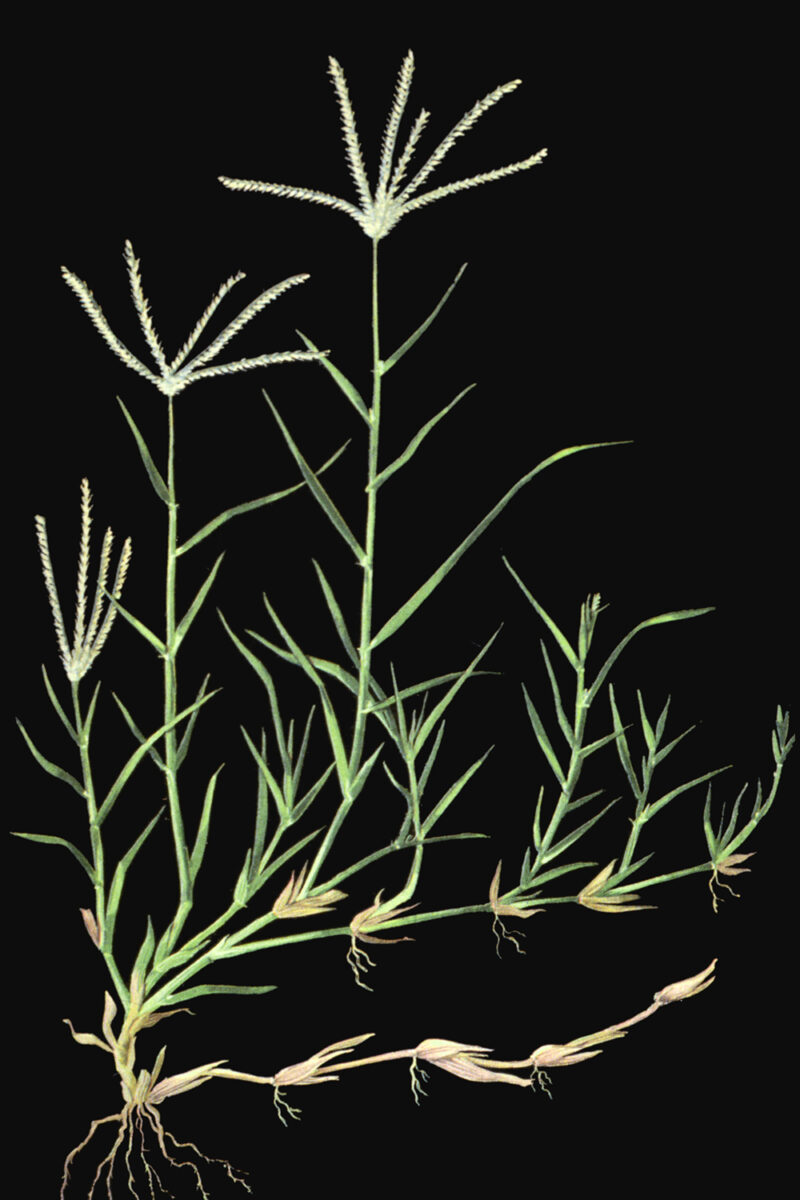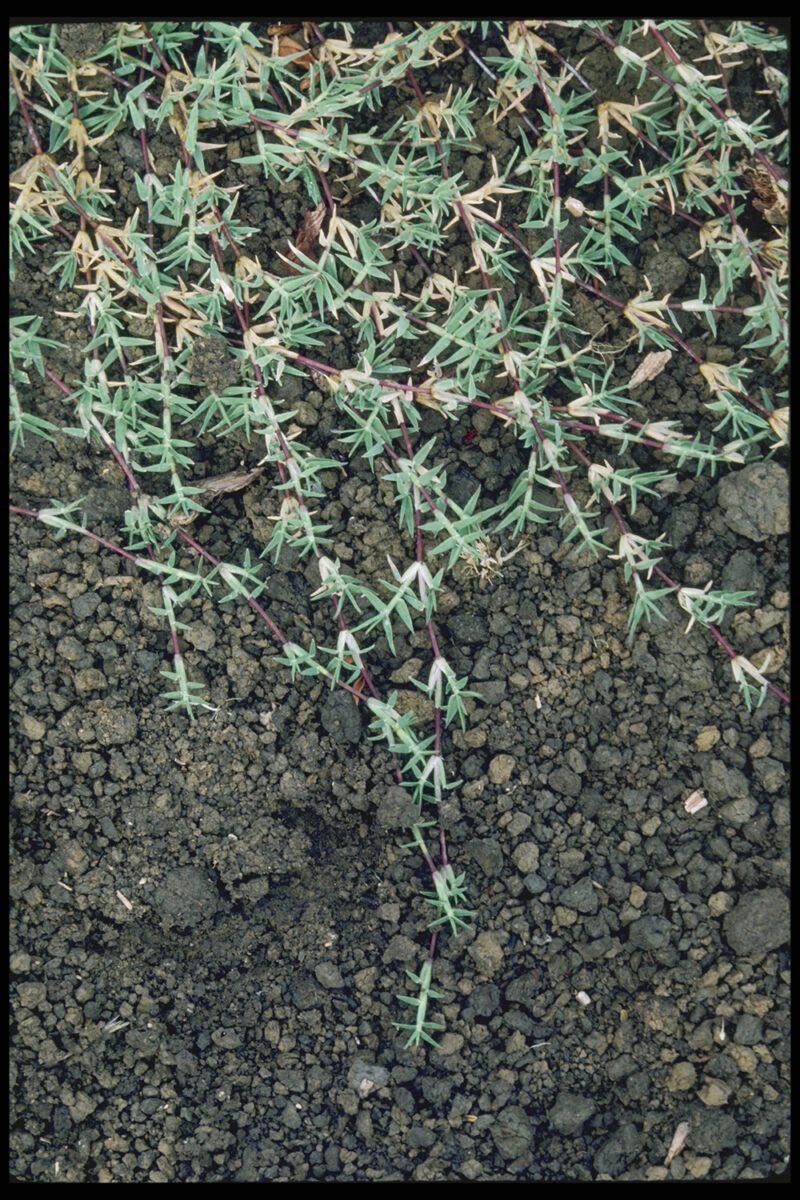Other common names: scutch grass, dogs-tooth grass, wire grass, couchgrass


Cynodon dactylon (L.) Pers.
Identification of Bermudagrass
Family: Grass family, Poaceae
Habit: Long-lived, prostrate, fine-leaved perennial grass that spreads by runners and rhizomes
Description: Seedling leaf sheaths and collars are smooth. Leaves are rolled in the bud and are smooth on both surfaces. The ligule is membranous, fringed and very short. Auricles are absent. The mature plant has erect stems up to 1.6 foot tall that arise from runners and rhizomes. Leaves are linear, 2–6.3 inches long by 0.08–0.2 inch wide, sometimes lightly hairy on the upper surface, and hairy on the lower surface. The collar region has an inconspicuous membranous ligule with a fringe of 0.01-inch-long hairs. Sheaths are sometimes hairy on lower leaves and have long, tufted hairs on their margins in the collar region. The plant has fibrous roots developing at nodes on the runners and rhizomes. Inflorescences are located at the end of stems in an arrangement of 3–9 spikes that are 1.2–4 inches long. Spikelets are 0.08–0.1 inch long and awnless; they consist of one flower that produces one light brown, egg-shaped seed.
Similar species: Creeping bentgrass (Agrostis stolonifera L.) also spreads through runners and rhizomes. However, it can be distinguished by its long, membranous ligules, smooth leaves and sheaths, and dense, open panicles.
Management of Bermudagrass
Bermudagrass is considered the world’s worst grass weed, and it infests 40 crops in over 80 countries. The tenacity with which it survives inhospitable conditions has led to its development as a forage and turfgrass as well as to its success as a weed. Management generally requires considerable effort and persistence since intermittent tillage only serves to spread the extensive network of rhizomes and runners. Consequently, preventing its invasion into non-infested fields is critical, for example by cleaning machinery before entering a field and digging out any clumps when they first appear.
Near the northern limits of its range where the soil freezes in winter, plow the field in the fall and work the rhizomes to the soil surface, where they will freeze. Plants will emerge from rhizomes that escape, but this can reduce the infestation. In regions with predictable drought, moldboard plow during drought, leaving a rough surface so that air penetrates the soil. One plowing during a protracted drought period will substantially reduce bermudagrass. For a more rapid and thorough kill, repeat tillage at four- to seven-day intervals until the soil is completely dry to the full depth of the plow layer, and then continue this for at least an additional two weeks. This will kill rhizomes to the depth of tillage. When rains return or the field is irrigated, follow up with cultivation and hand hoeing in the row to eliminate sprouts from deep rhizomes.
Competitive cover crops are effective for suppressing bermudagrass. Plant a dense stand of rye, winter oats or winter barley in the fall. Harvest this for grain or forage and plow under the stubble. Plant a highly competitive summer cover crop like cowpeas or velvetbeans. The one year of dense shade and early summer soil disturbance will greatly suppress the bermudagrass. Heavy competition from taller plants is particularly useful against bermudagrass due to its short stature. Also, the shade will lower leaf and soil temperatures, which will slow growth of this heat loving species. High density planting of the cover crops is critical to ensure rapid canopy closure and dense early shade.
Ecology of Bermudagrass
Origin and distribution: Bermudagrass is native to tropical Africa or possibly southern Asia but now occurs in most places between 45° N and 45° S latitude. It occurs throughout the United States except for some of the most northern parts of the Midwest and New England, but it is a serious weed primarily in the southern half of the country.
Seed weight: 0.23–0.36 mg.
Dormancy and germination: Seeds with hulls have low germination of 6–9%. Bermudagrass has negligible germination in the dark at any constant temperature. Fluctuating temperatures promote germination, and day/night temperature differences of more than 30°F are more effective than more moderate fluctuations. Light and nitrate further increase germination in a fluctuating temperature environment but are ineffective if the temperature is constant. Seeds will germinate in anaerobic conditions if other factors are favorable.
Seed longevity: No information on survival of bermudagrass seeds could be located. If the species is like most perennial grasses, the seeds disappear from the soil within a few years.
Season of emergence: In a California study, shoots began emerging from transplanted plugs when soil temperature at 2 inches reached 63°F. The rate of shoot emergence was slow in March and April but increased rapidly after mid-May.
Emergence depth: Seedlings emerge best from about 0.25 inch but emerge reasonably well from the top 1 inch of soil. None emerge from deeper than 2 inches. The rhizomes can occur as deep as 40 inches, and shoots can emerge from below the plow layer. However, shoots are less likely to emerge from rhizome fragments below 6 inches than from rhizome fragments at 2–4 inches.
Photosynthetic pathway: C4
Sensitivity to frost: Bermudagrass grows poorly in cold weather and quickly ceases growth after frost. Exposed rhizomes are killed by freezing. In contrast, the species thrives in climates where the temperature commonly reaches 100°F.
Drought tolerance: Bermudagrass becomes dormant during extended droughts and then sprouts from rhizomes when moisture is again available. However, its productivity and rate of clonal expansion respond strongly to water availability. Rhizomes can recover from short periods of low soil moisture but will not resprout after seven days of desiccation in completely dry soil. The species can also survive prolonged flooding.
Mycorrhiza: Bermudagrass is mycorrhizal.
Response to fertility: Bermudagrass is capable of surviving low fertility conditions. However, the growth of plants established from seeds responds strongly to N, P or K applied alone, and growth is even more rapid if the fertility is balanced. Established plants respond strongly to N fertilizers but respond to P and K only if N is not limiting.
Soil physical requirements: Bermudagrass can grow on any soil type from sand to heavy clay, but it grows best on medium to heavy textured soils that are well drained but remain moist.
Response to shade: Bermudagrass does not tolerate shade. In a series of experiments, the size of bermudagrass clones increased exponentially in response to the amount of sunlight received.
Sensitivity to disturbance: Bermudagrass can withstand frequent, intensive defoliation, and selections of the species are used for golf course greens, which are mowed daily to less than 0.375 inch. In temperate regions like the United States, carbohydrate reserves reach a peak in winter and decline to a low in mid-summer. Consequently, the species is most sensitive to disturbance of the rhizomes during mid-summer.
Time from emergence to reproduction: Small sod plugs, similar to what might be dispersed by tillage machinery, produced flowers in 10–15 weeks when planted in March to May in southern California. Those planted in June through September 1 flowered in as little as four weeks and produced seeds within eight weeks. A planting on October 1 did not flower.
Pollination: Bermudagrass is wind pollinated.
Reproduction: Most reproduction is by fragmentation of rhizomes and runners during tillage. Small four-node rhizome fragments buried at about 2.5 inches in the spring produced 3.3–6.6 feet of runners and 12–28 inches of rhizome in four weeks. These had approximately 20–40 runner nodes and 10–23 rhizome nodes. Heavier four-node fragments of both types produced a greater length of runners and rhizomes. Small sod plugs planted 8 inches apart in a row in southern California produced up to 85 rhizome nodes per square foot with the greatest density produced by plantings in March and July. Plugs planted in March produced 6,800 seeds per square foot, with seed production declining with later plantings through the spring and summer.
Dispersal: The seeds can survive at least 50 days of submergence in water. They disperse in irrigation water and probably also by overland flow and along streams. Seeds pass through cattle and are spread with the manure. The small seeds of bermudagrass can lodge in the fur of animals and thereby can be dispersed over large areas. Seeds do not shatter easily and are moved about with hay. Most dispersal, however, occurs by movement of vegetative parts. Tillage implements can drag rhizome and runner fragments long distances within fields. Rhizomes and runners get carried in mud on cattle and on farm machinery. Pieces of sod can float down streams. Runner fragments may be included in hay or lawn clippings used as mulch. The species has been dispersed between ports in ship ballasts and in packing materials.
Common natural enemies: Domestic cultivars of bermudagrass are attacked by a mirid bug (Trigonotylus doddi), fall armyworm (Spodoptera frugiperda), leafhoppers (mainly Carneocephala flaviceps, Exitianus exitiosus, Graminella nigrifrons, G. sonora, Draeculacephala balli and Cuerna costalis) and planthoppers (mainly Delphacodes propinqua and Sogatella kolophon). The species probably has similar susceptibility when growing as a weed.
Palatability: Bermudagrass is a high quality forage when young but quality deteriorates substantially as it matures. Mature bermudagrass can cause poisoning of cattle, horses and goats, possibly due to a fungal infection in the foliage, but cases are rare.
Summary Table of Bermudagrass Characteristics
| Bermudagrass | ||||||||
|---|---|---|---|---|---|---|---|---|
| Growth habit | Perennial overwinter organ | Emergence period from perennial organs | Optimum emergence depth (inches) from perennial organs | Time/stage of lowest reserves | Photosynthesis type | Frost tolerance | Drought tolerance | Mycorrhiza |
| prostrate grass | rhizomes | late spring | 2–4 | mid-summer | C4 | low | moderate | yes |
| Fertility response | Importance of seeds to weediness | Seed weight (mg) | Dormancy of shed seeds | Factors breaking dormancy | Optimum temperarature range (F) for seed germination | Seedling emergence period | Emergence to flowering (weeks) | |
| high | low | 0.23–0.36 | yes | li, at, ni | – | – | 10–15 | |
Table Key
Perennial overwinter organ: Principal plant organ that survives winter and from which growth resumes in subsequent years.
Emergence period from perennial organs: Time of year when most emergence occurs from perennial overwintering organs in the typical regions of occurrence for each weed. Some emergence may occur outside of this range.
Optimum emergence depth from perennial organs: Soil depths (in inches below the soil surface) from which most shoots emerge from perennial organs. Lower rates of emergence usually will occur at depths above or below this range.
Time/stage of lowest reserves: Time of year and/or weed growth stage at which carbohydrate reserves are lowest. This usually corresponds to the time when the weed is most susceptible to weed management operations.
Frost tolerance: Relative tolerance of aboveground shoots to freezing temperatures (high, moderate, low).
Drought tolerance: Relative tolerance of aboveground plants to drought (high, moderate, low).
Importance of seeds to weediness: The relative importance of seeds to dispersal, genetic diversity and survival of the species as a weed in agricultural environments (high, moderate, low). Emergence to flowering: Length of time (weeks) after emergence from perennial organs to the beginning of flowering in the typical regions of occurrence. Note that this refers to established perennial plants, recognizing that some species may not flower in their initial year of establishment.
Further Reading
Holm, L.G., D.L. Plucknett, J.V. Pancho and J.P. Herberger. 1977. The World's Worst Weeds: Distribution and Biology. The University Press of Hawaii: Honolulu.
Keeley, P.E. and R.J. Thullen. 1989. Influence of planting date on growth of bermudagrass (Cynodon dactylon). Weed Science 37: 531–537.
Mitich, L. 1989. Bermudagrass. Weed Technology 3: 433–435.
Phillips, M.C. 1993. Use of tillage to control Cynodon dactylon under small-scale farming conditions. Crop Protection 12: 267–272.

